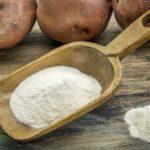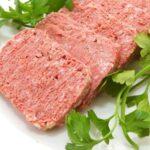Disappearing wild salmon populations have been a hot-button issue for years. Yet, few realize the environmental impact of their seemingly harmless dinner plate substitute: farmed salmon. The aquaculture industry has proliferating at breakneck speeds, but does it come with a hidden cost? In this blog post, we’ll take you deep under the surface and explore the unspoken relationship between salmon farming and our environment. We’ll also evaluate the sustainability of aquaculture practices – so before you savour your next seafood dish, arm yourself with the information that hinges upon not just your health but also the future of our planet.
Salmon farming has a significant environmental impact, including the spread of disease, pollution from excess feed and chemical treatments, overfishing of smaller fish species, and eutrophication caused by concentrated waste products. Additionally, escapes of farmed fish can lead to genetic pollution of wild populations. While some farms prioritize sustainable and eco-friendly practices, the overall environmental impact of salmon farming remains a concern for many individuals and organizations.
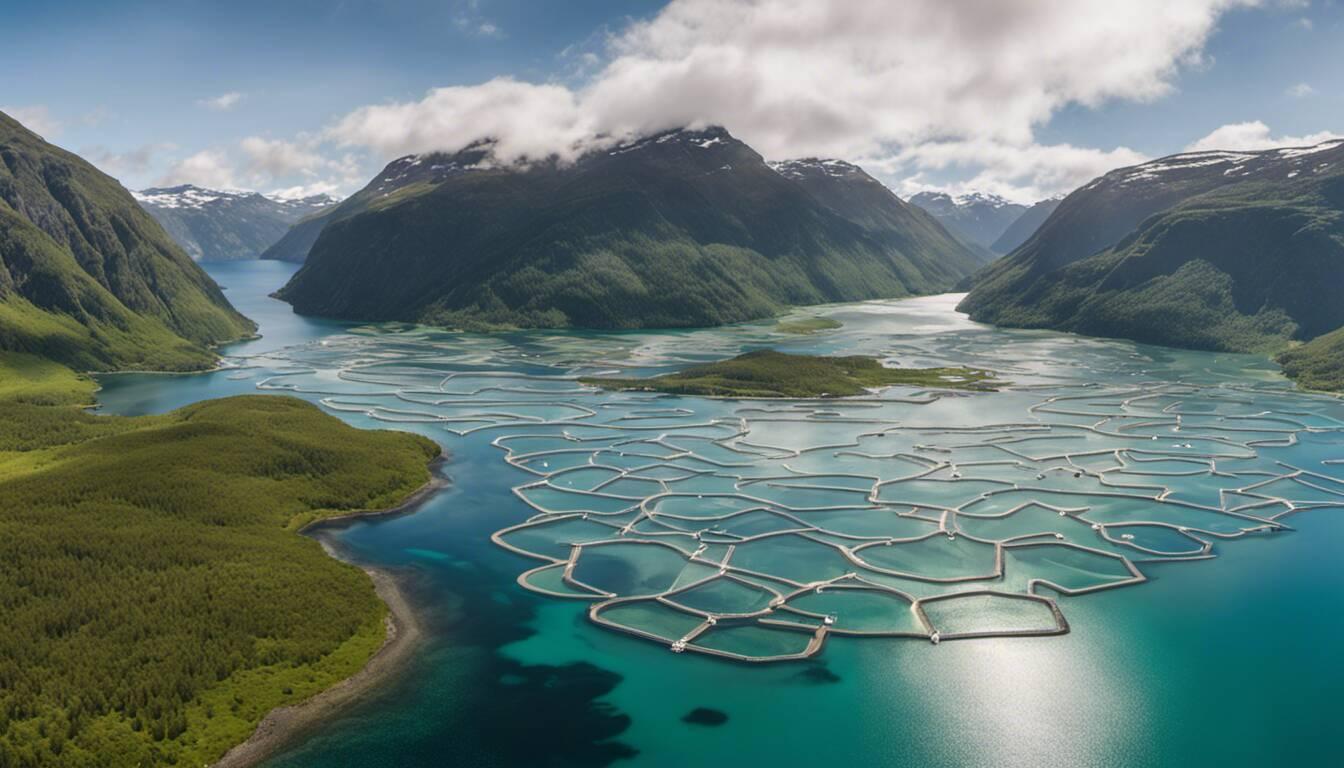
Environmental Consequences of Salmon Farming
The rapid expansion of salmon farming in recent years has raised concerns about its environmental impact. While the industry presents itself as a sustainable solution to meet the growing demand for seafood, it’s important to understand the potential consequences associated with salmon farming.
One of the major issues is the release of waste and chemicals into surrounding waters. Fish feces, uneaten food, and other pollutants accumulate on the ocean floor beneath salmon farms, smothering marine life and contributing to poor water quality. These substances can also promote the growth of harmful algal blooms, which not only deplete oxygen levels but also produce toxins that can harm fish and other organisms.
Additionally, farmed salmon are susceptible to diseases and infestations of sea lice. To combat these issues, farms often use pesticides and antibiotics, both of which have detrimental effects on the environment. These chemicals can enter the ecosystem through effluent discharge and pose significant risks to non-target species such as wild fish and shellfish.
Escaped farmed salmon also pose a threat to native species in surrounding areas. They can prey on or compete with wild fish for resources, disrupting local ecosystems. Furthermore, genetic interactions between escaped farmed salmon and their wild counterparts can weaken the genetic diversity and resilience of wild populations.
It’s worth noting that the production of feed for farmed salmon contributes to environmental degradation as well. The mass quantities of fish meal and oil required to support the industry puts strain on wild fisheries and contributes to overfishing. Additionally, producing and transporting feed contributes to greenhouse gas emissions and further exacerbates climate change.
Despite these challenges, there have been efforts within the industry to address environmental concerns. For example, containment systems have been developed that aim to minimize impacts by keeping farmed salmon contained within a controlled environment. These systems help reduce waste accumulation on ocean floors, limit interactions with wild populations, and mitigate disease transmission.
Overview of Global Salmon Farms
Salmon farming is a global industry that spans multiple regions, each with its unique characteristics. Norway is a dominant player in the market and has been a major producer of Atlantic salmon for decades. Other significant producers include Chile, Scotland, Canada, and the Faroe Islands.
Norway’s success in salmon farming can be attributed to its ideal geographical conditions, such as cold sea temperatures and clean water. It has a well-developed regulatory framework to ensure environmental sustainability and has made significant progress in minimizing the industry’s ecological footprint. However, challenges like sea lice infestations and escapes remain.
Chile has also emerged as a major player in the salmon farming industry, supplying a significant portion of salmon consumed globally. However, the country has faced controversies surrounding environmental impacts, including algal blooms and disease outbreaks. Efforts have been made to improve sustainability practices in Chilean salmon farms through stricter regulations and increased transparency.
Scotland is known for its high-quality Scottish salmon, which commands a premium in the market. The sector faces similar environmental challenges to other salmon-farming regions but is working towards implementing sustainable practices and reducing its ecological impact.
Canada’s salmon farming industry primarily operates on the west coast of British Columbia. Farms here face scrutiny due to concerns about wild salmon populations and interactions with indigenous communities that rely on traditional fishing practices.
The Faroe Islands, located between Iceland and Scotland, have experienced rapid growth in their salmon farming industry. Recently, the government proposed increasing taxes on the sector to ensure its long-term sustainability while addressing potential environmental risks.
It’s important to recognize that these are just a few examples of global salmon farms. Each region faces its own set of environmental challenges and opportunities as they strive to meet the demand for farmed salmon while minimizing negative impacts on ecosystems.
Now that we have explored the environmental consequences of salmon farming as well as an overview of global production regions, let’s dive deeper into the specific containment systems used in the industry and their potential impact on sustainability.
- Studies estimate that salmon farming produces nearly 70% of the world’s commercially sold salmon, a vast majority of it being farmed in tightly enclosed spaces.
- According to research published by the National Oceanic and Atmospheric Administration (NOAA), waste products from these farms can lead to eutrophication, threatening marine life and ecosystem health.
- Research from the World Wildlife Fund indicates that the pollution caused by excess feed and chemical treatments from salmon farms has a significant negative impact on surrounding ecosystems, contributing to the overfishing of smaller fish species essential to producing fishmeal for feed.
Introduction to Containment Salmon Farming
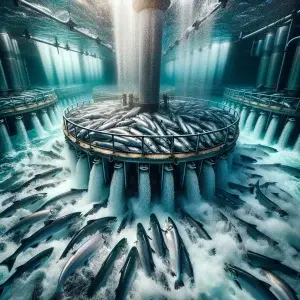
Traditional salmon farming practices have come under scrutiny due to their environmental impact on marine ecosystems. In response, the concept of containment salmon farming has emerged as a potential solution to mitigate these concerns. This innovative approach aims to confine farmed salmon in closed systems that minimize their interaction with the surrounding natural environment.
Unlike conventional netpen farming, where fish are raised in open water enclosures, containment salmon farming involves using closed-containment systems such as tanks or recirculating aquaculture systems (RAS). These systems offer better control over water quality, waste management, and disease prevention. By reducing interactions between farmed and wild fish, containment salmon farming seeks to address key sustainability issues associated with traditional methods.
The transition from netpens to containment systems entails implementing various technologies and infrastructure. Measures such as barrier shields, air bubble curtains, oxygen systems, and real-time environmental monitoring technology are being incorporated by British Columbia-based salmon farmers to minimize exchanges between farmed and wild fish.
Picture a state-of-the-art containment facility equipped with sophisticated sensors monitoring water quality parameters in real time. The oxygen levels, temperature, and pH of the water are continuously optimized to create an ideal environment for the fish. Waste is efficiently managed through advanced filtration systems that remove excess nutrients and prevent contamination of surrounding waters.
While containment salmon farming shows promise for reducing the negative environmental impacts associated with traditional methods, it’s important to note that there still remain uncertainties regarding its adoption as the primary form of transition for the salmon industry in western Canada. Canada Fisheries Minister Joyce Murray is yet to provide clarity on what technology will be approved as part of the transition plan. Nevertheless, containment salmon farming represents a significant step towards achieving greater sustainability in aquaculture.
Now that we have explored the introduction to containment salmon farming, let’s delve into the detrimental effects of traditional salmon farming methods on the marine environment.
Detrimental Effect on the Marine Environment 🌊
Traditional salmon farming practices have been criticized for their negative impact on the marine environment. A primary issue is pollution caused by excess nutrients and chemicals used in feed production. Salmon farms require large quantities of fish meal and oil, which are obtained from wild-caught fish species such as herring and anchovies. The extraction of these resources can disrupt food chains and deplete populations of other marine species. 🐟🔗
Moreover, uneaten feed and feces produced by farmed salmon contribute to nutrient enrichment in surrounding waters. High nutrient levels can lead to harmful algal blooms, oxygen depletion, and changes in water chemistry, affecting the health of local ecosystems. These blooms result from excess nitrogen and phosphorus from salmon waste and feed runoff, leading to eutrophication and negative impacts on biodiversity. 🌿🚫
Imagine a scenario where a salmon farm with thousands of fish produces significant waste daily. This waste enters the sea, creating an imbalance in nutrient levels that encourages toxic algal growth. As a result, these algal blooms consume available oxygen, creating “dead zones” where marine life struggles to survive. 🐠💀
Lastly, high parasite infestations, especially sea lice, are another problem with traditional netpen farming. These parasites pose a threat not just to farmed salmon but also to wild fish populations nearby. Infected farmed salmon can spread parasites to migrating wild salmon during critical life phases. This interaction between farmed and wild fish can severely affect the sustainability and genetic integrity of wild salmon populations. 🦠🛑
Having explored the detrimental effects of traditional salmon farming on the marine environment, it’s crucial that we address these challenges to ensure the long-term sustainability of our oceans.
- Traditional salmon farming practices have a negative impact on the marine environment due to pollution caused by excess nutrients and chemicals used in feed production. The extraction of wild-caught fish species for feed can disrupt food chains and deplete populations of other marine species, while uneaten feed and feces contribute to nutrient enrichment in surrounding waters, leading to harmful algal blooms, oxygen depletion, and changes in water chemistry. High parasite infestations are also a concern, as they can spread from farmed to wild fish populations. Addressing these challenges is crucial for the long-term sustainability of our oceans.
Nutrients and Chemicals in Feed Production
The success of salmon farming relies heavily on the feed given to the farmed fish. The feed composition not only affects the health and growth of the salmon but also plays a role in the environmental impact of salmon farming. The nutrient content and potential chemical additives used in feed production have significant implications for sustainability.
The feed provided to farmed salmon comprises a variety of ingredients, including fishmeal, fish oil, vegetable proteins, and oils. These are carefully formulated to provide the necessary nutrients for optimal growth and health. However, relying on fishmeal and fish oil raises concerns about its sustainability due to overfishing of small pelagic species used for these ingredients.
To address this challenge, alternative feed ingredients such as plant-based proteins (like soybean meal) and oils have been introduced into salmon feeds. These substitutes can help reduce the dependence on fishmeal and fish oil, alleviating pressure on marine ecosystems.
| Aspects | Nutrients |
|---|---|
| Proteins | Essential for growth, maintenance, and reproductive functions |
| Fatty Acids | Vital for energy storage, structural integrity, and metabolic processes |
| Minerals | Required for various physiological functions |
| Antioxidants | Support immune system and overall health |
However, concerns arise regarding potential chemicals used in feed production. For example, astaxanthin, an antioxidant included in the feed to give salmon its characteristic pink color, is essential for proper nutrition. While naturally occurring astaxanthin is preferable, synthetic alternatives are sometimes used. Ensuring that feed suppliers adhere to strict regulations regarding additives is crucial to minimize risks associated with potentially harmful substances.
In essence, efforts are being made to improve sustainability through innovative feed formulations that reduce reliance on finite resources like fishmeal and fish oil while maintaining appropriate nutritional profiles.
Now that we’ve explored the role of nutrients and chemicals in salmon feed production, let’s turn our attention to another critical aspect – pollution stemming from salmon farms.
Pollution Stemming from Salmon Farms
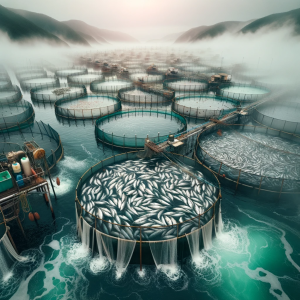
While salmon farming is an integral part of meeting global seafood demands, 🍣 it comes with various environmental challenges 🌏. One challenge is pollution, which can negatively impact marine ecosystems and coastal communities where these farms are located.
Salmon farms generate waste in the form of uneaten feed, fish excrement, and excess nutrients from feed. 🐟💩 This waste can accumulate on the seafloor, potentially degrading water quality and harming benthic organisms, coral reefs, and other sensitive habitats. 🐚🦑
Use of antibiotics, pesticides, and antifoulants to combat diseases and parasites has raised concerns 🤔. These substances can enter local waters through discharge or leaching into the surrounding ecosystem. While measures exist to regulate their usage, proper management and adherence to guidelines are crucial for minimizing negative ecological effects. 📝👮♀️
Habitat alteration and loss are additional challenges. 🌳 The physical infrastructure required for farms can lead to habitat destruction if not adequately designed or managed. Also, the release of non-native species from escape events can result in competition with native species, impacting biodiversity. 🦈🌿
Critics argue that the expansion of salmon farming exacerbates these issues due to intensive production methods and overcrowded conditions. 👥 They believe that more stringent regulations and enforcement are necessary to mitigate these environmental impacts effectively. ⚖️
However, proponents contend that advancements in technology and industry practices have allowed for more sustainable salmon farming. They believe that implementing best management practices like improved waste management systems and investing in closed-containment aquaculture could significantly reduce pollution risks associated with open-net pen farming.
Visualize a garden where excessive fertilizer application leads to water contamination and harms the surrounding environment. Similarly, the excess nutrients from salmon farms, if not properly managed, can cause similar ecological disturbances in marine ecosystems.
Overall, addressing pollution stemming from salmon farms requires a comprehensive and collaborative approach involving industry stakeholders, policymakers, and environmental organizations. By focusing on sustainable practices, monitoring water quality, and implementing effective waste management systems, it is possible to minimize the environmental impacts associated with salmon farming.
Influence on Wild Salmon Populations
The exponential growth of open-net salmon farming has raised concerns 🚨 about its impact on wild salmon populations. 🐟 In Iceland, for example, the escape of farmed salmon from open-net pens has been observed in numerous rivers across the country. This escape poses a significant threat to the survival of wild salmon.
Escaped farmed fish can interbreed with wild fish, 🐠💞 giving rise to hybrid offspring that have the potential to undermine the natural reproductive abilities of the species. 🧬 The extent of hybridization may be even more extensive than previously believed, suggesting that these hybrids can not only survive but also reproduce successfully.
An important consequence of this interbreeding is that hybrid offspring tend to mature at a faster rate 🌱 and at a younger age than their wild counterparts. This early maturation disrupts the natural life cycle of wild salmon and further diminishes their ability to reproduce in nature. As a result, the decline of wild Atlantic salmon populations has significant ecological implications 🌍 for mammals and birds that depend on them for sustenance.
Escaped farmed fish also carry another formidable threat: sea lice 🦠. In open-net pen farms, sea lice infestations can rapidly spread and cause severe harm to both the captive and surrounding wild population.
Aside from the direct impact on wild salmon, open-net fish farms also contribute to pollution in marine ecosystems. 🌊 Organic waste generated by fish farming accumulates beneath these farms, disturbing the balance and health of coastal environments. Additionally, pesticides used to treat sea lice infestations can further pollute surrounding waters. 💧
The growth of Iceland’s open-net salmon farming industry has exposed underlying issues related to regulatory oversight and breaches of regulations. 📜 Patchy regulation and weak oversight have undoubtedly contributed to these challenges. To address these concerns adequately, calls for stronger restrictions and possible bans on open-pen fish farming have been reignited. 🔥
Mortality Rates among Farmed Fish
While the impact of salmon farming on wild populations raises ecological concerns, 🌍 it’s also important to examine the mortality rates among farmed fish themselves. 🐟 Despite adverse environmental conditions like high seawater temperatures due to the El Niño weather warming phenomenon, the survival rates of farmed salmon have shown improvement compared to previous years.
| Factors Affecting Survival | Mitigation Measures |
|---|---|
| Declining oxygen levels | Improved water oxygenation systems 🌬️ |
| Exposure to sea risks | Reduced time spent in sea 🌊 |
| Potential health threats | Improved monitoring and early detection ⚠️ |
| Inadequate nutrients | Refined nutrition and feeding protocols 🍽️ |
Mitigation measures implemented by salmon farmers have played a crucial role in enhancing survival rates. These measures include improved water oxygenation systems to alleviate the effects of declining oxygen levels caused by warmer temperatures. Farmers have also reduced the time spent in the sea, minimizing exposure to risks during vulnerable periods. Improved monitoring practices enable early detection and response to potential threats, resulting in better overall outcomes.
Additionally, advancements in feeding strategies 🍽️ have contributed significantly to higher survival rates. Refined nutrition programs and feeding protocols tailored to the specific needs of farmed salmon help optimize health and growth. By ensuring that fish are receiving adequate nutrients, farmers can mitigate potential health issues that could lead to mortality.
It’s worth noting that despite these positive trends, challenges persist. 🚧 High seawater temperatures and associated factors like jellyfish blooms and algal blooms can still impact farmed salmon populations. However, experts remain optimistic as these temporary phenomena are expected to subside as seawater temperatures return to average levels in future years.
The salmon industry continues its commitment to improving survival rates 📈 and addressing environmental challenges posed by climate change 🌍. For example, through ongoing research and development efforts, innovative solutions will emerge that focus on sustainable aquaculture practices without compromising the well-being of both farmed and wild salmon populations.
Sustainability Practices in Salmon Aquaculture
As the demand for salmon keeps rising, making sure that salmon farms are green and good for the Earth is key. Many salmon farms now use better ways to limit their harm on nature and wild fish.
🔍 Key Methods for Sustainable Salmon Farming
- Tank-Based Systems: This system removes worries about the damage that warmer ocean water and pollution from fish waste can do to wild areas.
- Example: The Freshwater Institute in Shepherdstown, W.Va., uses tanks to raise salmon.
- Benefit: Smart water system uses very little fresh water.
- Optimal Feeding Practices: Better ways to feed fish also play a big part in making salmon farming more green.
- Benefit: Lowers harm to the Earth and makes the farm fish healthier.
- Disease Prevention: Many farms keep a tight watch on fish health to lower the disease risk.
- Benefit: Regular checks and tests spot signs of sickness early to stop outbreaks.
Table: Benefits of Sustainable Practices
| Practice | Environmental Benefit | Benefit for Salmon |
|---|---|---|
| Tank-Based Systems | Reduces ocean pollution | Controlled growth |
| Optimal Feeding | Reduces waste and pollution | Healthier fish |
| Disease Prevention | Limits risk to wild populations | Lowers disease risk |
Using these green methods helps meet the high need for salmon without hurting the Earth or wild fish. Research and teamwork in the industry are also collecting helpful data to make fish farming even better. While good practices are key for cutting the harm of salmon farming, farm rules also need review and change.
Improving Farm Conditions and Regulations

To keep salmon farms going for a long time, many steps are taken to make them better and set firm rules. 🌿
- This includes focusing on:
- Waste Control
- Water Health
- Farm and Wild Fish Relations
🗑️ One focus is on waste systems at salmon farms.
- Farms use many ways like tanks and filters to cut waste going into the sea.
💧 Keeping water clean is key for green salmon farms.
- Farms check things like oxygen and pH to keep fish healthy.
- Better tech helps monitor the water well, so farming doesn’t make it worse.
🐟 Steps are also in place to lower bad contact between farm fish and wild fish.
- These measures include:
- Putting farms far from where wild fish travel
- Making sure escapee fish don’t mate with wild ones
- This keeps wild fish groups strong.
📜 For instance, Iceland aims to set new rules for salmon farming.
- The plan rewards those who invest in good gear, ways, and staff.
- It also has money for study, checks, and licenses.
- The big aim is to make farm conditions better and still be green.
🤝 Work by industry people, officials, and scientists keeps making farm rules better.
- Main Aim: To meet the need for salmon but also keep the Earth safe.
| Before Enhancements | After Enhancements |
|---|---|
| Old Rules | New Icelandic Rules |
| Less Tech | Better Tech |
| No Checks | Regular Checks |
| Less Safe Earth | More Safe Earth |
